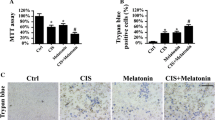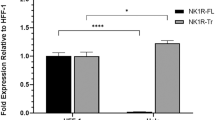Abstract
Cervical cancer is the most prevalent cancer in females. Melatonin, a neurohormone has been documented as a promising therapeutic molecule for cervical cancer. However, the underlying molecular mechanism is not known. We explored the dose-dependent anti-tumor response of melatonin against cervical cancer cell lines, HeLa (HPV-18 positive) and SiHa (HPV-16 positive). The anti-cancer effect of melatonin was evaluated by MTT assay, cell imaging, colony formation, DAPI, AO/PI, LDH, Flow cytometry, scratch assay, western blot analysis and real-time PCR. Results of DAPI, AO/PI, LDH, and Annexin/PI staining revealed that melatonin induces apoptosis. The results of cell cycle analysis revealed that melatonin arrests the HeLa and SiHa cells in sub-G1 and G1 phases, respectively. Western blot analysis revealed that melatonin downregulated the expression of pro-inflammatory transcription factor, NF-κB and the expression of COX-2 protein, a key mediator in cell proliferation. In addition, melatonin downregulated the expression of an invasive marker, MMP-9, an antiapoptotic protein, Bcl-2, and upregulated the expression of pro-apoptotic protein, Bax at both transcriptional and translational levels. Overall, the results suggest that melatonin exhibited strong anti-cancer therapeutic potential against human cervical cancer cell line progression possibly through inhibition of NF-κB signalling pathway.









Similar content being viewed by others
Availability of data
All data are available for publication.
References
Ahmad R, Haldar C (2010) Photoperiodic regulation of MT1 and MT2 melatonin receptor expression in spleen and thymus of a tropical rodent Funambulus pennanti during reproductively active and inactive phases. Chronobiol Int 27(3):446–462
Altun I, Sonkaya A (2018) The most common side effects experienced by patients were receiving first cycle of chemotherapy. Iran J Public Health 47(8):1218–1219
Asting AG, Carén H, Andersson M, Lönnroth C, Lagerstedt K, Lundholm K (2011) COX-2 gene expression in colon cancer tissue related to regulating factors and promoter methylation status. BMC Cancer 11(1):1–10
Awasthee N, Rai V, Verma SS, Francis KS, Nair MS, Gupta SC (2018) Anti-cancer activities of Bharangin against breast cancer: evidence for the role of NF-κB and lncRNAs. Biochim Et Biophys Acta (BBA) 1862(12):2738–2749
Beauchamp C, Fridovich I (1971) Superoxide dismutase: improved assays and an assay applicable to acrylamide gels. Anal Biochem 44(1):276–287
Bentivegna E, Gouy S, Maulard A, Chargari C, Leary A, Morice P (2016) Oncological outcomes after fertility-sparing surgery for cervical cancer: a systematic review. Lancet Oncol 17(6):e240–e253
Bikfalvi A (2017) History and conceptual developments in vascular biology and angiogenesis research: a personal view. Angiogenesis 20(4):463–478
Burdon R (1996) Control of cell proliferation by reactive oxygen species. Biochem Soc Trans 24(4):1028–1032
Cabrera J, Negrín G, Estévez F, Loro J, Reiter RJ, Quintana J (2010) Melatonin decreases cell proliferation and induces melanogenesis in human melanoma SK-MEL-1 cells. J Pineal Res 49(1):45–54
Chen G, Li X, Yang J, Li J, Wang X, He J et al (2016) Prognostic significance of cyclooxygenase-2 expression in patients with hepatocellular carcinoma: a meta-analysis. Arch Med Sci 12(5):1110
Choi B-Y, Kim H-Y, Lee K-H, Cho Y-H, Kong G (1999) Clofilium, a potassium channel blocker, induces apoptosis of human promyelocytic leukemia (HL-60) cells via Bcl-2-insensitive activation of caspase-3. Cancer Lett 147(1–2):85–93
Chuffa LGA, Fioruci-Fontanelli BA, Mendes LO, Seiva FRF, Martinez M, Fávaro WJ et al (2015) Melatonin attenuates the TLR4-mediated inflammatory response through MyD88-and TRIF-dependent signaling pathways in an in vivo model of ovarian cancer. BMC Cancer 15(1):1–13
Cury-Boaventura MF, Pompéia C, Curi R (2004) Comparative toxicity of oleic acid and linoleic acid on Jurkat cells. Clin Nutr 23(4):721–732
da Costa RMG, Bastos MM, Medeiros R, Oliveira PA (2016) The NFκB signaling pathway in papillomavirus-induced lesions: friend or foe? Anticancer Res 36(5):2073–2083
Festa-Vasconcellos JS, Piranda DN, Amaral LM, Indio-do-Brasil V, Koifman S, Vianna-Jorge R (2012) Polymorphisms in cycloxygenase-2 gene and breast cancer prognosis: association between PTGS2 haplotypes and histopathological features. Breast Cancer Res Treat 132(1):251–258
Gately S, Li WW (2004) Multiple roles of COX-2 in tumor angiogenesis: a target for antiangiogenic therapy. Semin Oncol 31:2–11
Ghosh N, Chaki R, Mandal V, Mandal SC (2010) COX-2 as a target for cancer chemotherapy. Pharmacol Rep 62(2):233–244
Gomes M, Teixeira AL, Coelho A, Araújo A, Medeiros R (2014) The role of inflammation in lung cancer. Inflammation and cancer. Springer, Berlin, pp 1–23
Gupta SC, Kim JH, Prasad S, Aggarwal BB (2010) Regulation of survival, proliferation, invasion, angiogenesis, and metastasis of tumor cells through modulation of inflammatory pathways by nutraceuticals. Cancer Metastasis Rev 29(3):405–434
Gupta SC, Prasad S, Sethumadhavan DR, Nair MS, Mo Y-Y, Aggarwal BB (2013) Nimbolide, a limonoid triterpene, inhibits growth of human colorectal cancer xenografts by suppressing the proinflammatory microenvironment. Clin Cancer Res 19(16):4465–4476
Hartwell LH, Kastan MB (1994) Cell cycle control and cancer. Science 266(5192):1821–1828
Kwan YP, Saito T, Ibrahim D, Al-Hassan FMS, Ein Oon C, Chen Y et al (2016) Evaluation of the cytotoxicity, cell-cycle arrest, and apoptotic induction by Euphorbia hirta in MCF-7 breast cancer cells. Pharm Biol 54(7):1223–1236
Lai JC-Y, Chou Y-J, Huang N, Tsai J-J, Huang S-M, Yang Y-C et al (2013) Survival analysis of Stage IIA1 and IIA2 cervical cancer patients. Taiwan J Obstet Gynecol 52(1):33–38
Li Y, Li S, Zhou Y, Meng X, Zhang J-J, Xu D-P et al (2017) Melatonin for the prevention and treatment of cancer. Oncotarget 8(24):39896
Liang X-J, Chen C, Zhao Y, Wang PC (2010) Circumventing tumor resistance to chemotherapy by nanotechnology. Multi-drug resistance in cancer. Springer, Berlin, pp 467–488
Lin CL, Chen HJ, Hou WC (2002) Activity staining of glutathione peroxidase after electrophoresis on native and sodium dodecyl sulfate polyacrylamide gels. Electrophoresis 23(4):513–516
Lin CY, Lovén J, Rahl PB, Paranal RM, Burge CB, Bradner JE et al (2012) Transcriptional amplification in tumor cells with elevated c-Myc. Cell 151(1):56–67
Muñoz N, Castellsagué X, de González AB, Gissmann L (2006) HPV in the etiology of human cancer. Vaccine 24:S1–S10
Okazawa M, Mabuchi S, Isohashi F, Suzuki O, Yoshioka Y, Sasano T et al (2013) Impact of the addition of concurrent chemotherapy to pelvic radiotherapy in surgically treated stage IB1-IIB cervical cancer patients with intermediate-risk or high-risk factors: a 13-year experience. Int J Gynecol Cancer 23(3):567–575
Park E-J, Cheenpracha S, Chang LC, Kondratyuk TP, Pezzuto JM (2011) Inhibition of lipopolysaccharide-induced cyclooxygenase-2 and inducible nitric oxide synthase expression by 4-[(2′-O-acetyl-α-L-rhamnosyloxy) benzyl] isothiocyanate from Moringa oleifera. Nutr Cancer 63(6):971–982
Pittayapruek P, Meephansan J, Prapapan O, Komine M, Ohtsuki M (2016) Role of matrix metalloproteinases in photoaging and photocarcinogenesis. Int J Mol Sci 17(6):868
Qin S, Zhang Z, Li J, Zang L (2014) FRZB knockdown upregulates β-catenin activity and enhances cell aggressiveness in gastric cancer. Oncol Rep 31(5):2351–2357
Roa JC, Garcia P, Gomez J, Fernández W, Gaete F, Espinoza A et al (2009) HPV genotyping from invasive cervical cancer in Chile. Int J Gynecol Obstet 105(2):150–153
Rouhollahi E, Moghadamtousi SZ, Paydar M, Fadaeinasab M, Zahedifard M, Hajrezaie M et al (2015) Inhibitory effect of Curcuma purpurascens BI. rhizome on HT-29 colon cancer cells through mitochondrial-dependent apoptosis pathway. BMC Complement Altern Med 15(1):1–12
Saavedra KP, Brebi PM, Roa JCS (2012) Epigenetic alterations in preneoplastic and neoplastic lesions of the cervix. Clin Epigenetics 4(1):1–7
Savvidis C, Koutsilieris M (2012) Circadian rhythm disruption in cancer biology. Mol Med 18(9):1249–1260
Schwartzman RA, Cidlowski JA (1993) Apoptosis: the biochemistry and molecular biology of programmed cell death. Endocr Rev 14(2):133–151
Sharma G, Rana NK, Singh P, Dubey P, Pandey DS, Koch B (2017) p53 dependent apoptosis and cell cycle delay induced by heteroleptic complexes in human cervical cancer cells. Biomed Pharmacother 88:218–231
Shiu SY, Law IC, Lau KW, Tam PC, Yip AW, Ng WT (2003) Melatonin slowed the early biochemical progression of hormone-refractory prostate cancer in a patient whose prostate tumor tissue expressed MT1 receptor subtype. J Pineal Res 35(3):177–182
Sovak MA, Bellas RE, Kim DW, Zanieski GJ, Rogers AE, Traish AM et al (1997) Aberrant nuclear factor-kappaB/Rel expression and the pathogenesis of breast cancer. J Clin Investig 100(12):2952–2960
Talib WH, Alsayed AR, Abuawad A, Daoud S, Mahmod AI (2021) Melatonin in cancer treatment: current knowledge and future opportunities. Molecules 26(9):2506
Verma SS, Rai V, Awasthee N, Dhasmana A, Rajalaksmi DS, Nair MS et al (2019) Isodeoxyelephantopin, a sesquiterpene lactone induces ROS generation, suppresses NF-κB activation, modulates LncRNA expression and exhibit activities against breast cancer. Sci Rep 9(1):1–16
Wang T-H, Lin Y-S, Chen Y, Yeh C-T, Huang Y-L, Hsieh T-H et al (2015) Long non-coding RNA AOC4P suppresses hepatocellular carcinoma metastasis by enhancing vimentin degradation and inhibiting epithelial-mesenchymal transition. Oncotarget 6(27):23342
Wang T-H, Wu C-H, Yeh C-T, Su S-C, Hsia S-M, Liang K-H et al (2017) Melatonin suppresses hepatocellular carcinoma progression via lncRNA-CPS1-IT-mediated HIF-1α inactivation. Oncotarget 8(47):82280
Weydert CJ, Cullen JJ (2010) Measurement of superoxide dismutase, catalase and glutathione peroxidase in cultured cells and tissue. Nat Protoc 5(1):51–66
Woodbury W, Spencer A, Stahmann M (1971) An improved procedure using ferricyanide for detecting catalase isozymes. Anal Biochem 44(1):301–305
Yamaguchi H, Condeelis J (2007) Regulation of the actin cytoskeleton in cancer cell migration and invasion. Biochim Et Biophys Acta (BBA) 1773(5):642–652
Yang M, Huang C-Z (2015) Mitogen-activated protein kinase signaling pathway and invasion and metastasis of gastric cancer. World J Gastroenterol 21(41):11673
Yordanov G, Skrobanska R, Petkova M (2016) Poly (butyl cyanoacrylate) nanoparticles stabilised with poloxamer 188: particle size control and cytotoxic effects in cervical carcinoma (HeLa) cells. Chem Pap 70(3):365–374
Zhang HM, Zhang Y (2014) Melatonin: a well-documented antioxidant with conditional pro-oxidant actions. J Pineal Res 57(2):131–146
Zhao Y-R, Li H-M, Zhu M, Li J, Ma T, Huo Q et al (2018) Non-benzoquinone geldanamycin analog, WK-88-1, induces apoptosis in human breast cancer cell lines. J Microbiol Biotechnol 28(4):542–550
Acknowledgements
The authors are also thankful to Dr. Rahul Kumar Singh, Department of Zoology, BHU for providing Chemi-Doc facility. We are also thankful to Interdisciplinary School of Life Sciences (ISLS), BHU for flow cytometry and real-time PCR facilities.
Funding
The authors are thankful to the Indian Council of Medical Research (ICMR), New Delhi (ICMR Adhoc Project P-14/267) for the financial assistance to Dr. Sanjeev Kumar Yadav. The JRF fellowship to Mr. Tarun Minocha from UGC-CAS, Dept of Zoology, BHU is highly acknowledged.
Author information
Authors and Affiliations
Contributions
SKY contributed to the study design. TM and MD performed experiments. SSV, NA and VR performed the statistical analysis. SKY wrote the manuscript. SCG and CH revised the manuscript. All authors read and approved the final manuscript.
Corresponding author
Ethics declarations
Conflict of interest
The authors have no conflict of interest that could be distinguished as discriminating the impartiality of the review reported.
Additional information
Publisher's Note
Springer Nature remains neutral with regard to jurisdictional claims in published maps and institutional affiliations.
Rights and permissions
About this article
Cite this article
Minocha, T., Das, M., Rai, V. et al. Melatonin induces apoptosis and cell cycle arrest in cervical cancer cells via inhibition of NF-κB pathway. Inflammopharmacol 30, 1411–1429 (2022). https://doi.org/10.1007/s10787-022-00964-6
Received:
Accepted:
Published:
Issue Date:
DOI: https://doi.org/10.1007/s10787-022-00964-6




